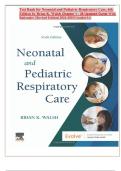Test Bank for Neonatal and Pediatric Respiratory Care, 6th
Edition by Brian K. Walsh Chapter 1 - 36 Updated Guide With
Rationales | Revised Edition| 2024-2025| Graded A+|
, Test Bank for Neonatal and Pediatric Respiratory Care, 6th
Edition by Brian K. Walsh Chapter 1 - 36 Updated Guide With
Rationales | Revised Edition| 2024-2025| Graded A+|
Table of Contents
Chapter 1. Fetal Lung Development
Chapter 2. Fetal Gas Exchange and Circulation
Chapter 3. Antenatal Assessment and High-Risk Delivery
Chapter 4. Examination and Assessment of the Neonatal and Pediatric Patient
Chapter 5. Pulmonary Function Testing and Bedside Pulmonary Mechanics
Chapter 6. Radiographic Assessment
Chapter 7. Pediatric Flexible Bronchoscopy
Chapter 8. Invasive Blood Gas Analysis and Cardiovascular Monitoring
Chapter 9. Noninvasive Monitoring in Neonatal and Pediatric Care
Chapter 10. Oxygen Administration
Chapter 11. Aerosols and Administration of Inhaled Medications
Chapter 12. Airway Clearance Techniques and Hyperinflation Therapy
Chapter 13. Airway Management
Chapter 14. Surfactant Replacement Therapy
Chapter 15. Noninvasive Mechanical Ventilation and Continuous Positive Pressure of the Neonate
Chapter 16. Noninvasive Mechanical Ventilation of the Newborn and Child
Chapter 17. Invasive Mechanical Ventilation of the Neonate and Pediatric Patient
Chapter 18. Administration of Gas Mixtures
Chapter 19. Extracorporeal Membrane Oxygenation
Chapter 20. Pharmacology
Chapter 21. Thoracic Organ Transplantation
Chapter 22. Neonatal Pulmonary Disorders
Chapter 23. Surgical Disorders in Childhood that Affect Respiratory Care
Chapter 24. Congenital Cardiac Defects
Chapter 25. Pediatric Sleep-Disordered Breathing
Chapter 26. Pediatric Airway Disorders and Parenchymal Lung Diseases
Chapter 27. Asthma
Chapter 28. Cystic Fibrosis
Chapter 29. Acute Respiratory Distress Syndrome
Chapter 30. Shock
Chapter 31. Pediatric Trauma
Chapter 32. Disorders of the Pleura
Chapter 33. Neurological and Neuromuscular Disorders
Chapter 34. Pediatric Emergencies
Chapter 35. Home Care of the Postpartum Family
Chapter 36. Quality and Safety
, Test Bank for Neonatal and Pediatric Respiratory Care, 6th
Edition by Brian K. Walsh Chapter 1 - 36 Updated Guide With
Rationales | Revised Edition| 2024-2025| Graded A+|
Chapter 1: Fetal Lung Development
Walsh: Neonatal & Pediatric Respiratory Care 6th Edition Test Bank 2024
MULTIPLE CHOICE
1. Which of the below phases of human lung development is characterized by the formationof
a capillary network around airway passages?
a. Pseudoglandular
b. Saccular
c. Alveolar
d. Canalicular
CORRECT: D
The canalicular phase follows the pseudoglandular phase, lasting from approximately 17
weeks to 26 weeks of gestation. This phase is so named because of the appearance of vascular
channels, or capillaries, which begin to grow by forming a capillary network around the air
passages. During the pseudoglandular stage, which begins at day 52 and extends to week 16
of gestation, the airway system subdivides extensively and the conducting airway system
develops, ending with the terminal bronchioles. The saccular stage of development, which
takes place from weeks 29 to 36 of gestation, is characterized by the development of sacs that
later become alveoli. During the saccular phase, a tremendous increase in the potential gas-
exchanging surface area occurs. The distinction between the saccular stage and the alveolar
stage is arbitrary. The alveolar stage stretches from 39 weeks of gestation to term. This stage
is represented by the establishment of alveoli.
REFERENCE: pp. 3-5
2. Regarding postnatal lung growth, by approximately what age do most of the alveoli that will
be present in the lungs for life develop?
a. 6 months
b. 1 year
c. 1.5 years
d. 2 years
CORRECT: C
Most of the postnatal formation of alveoli in the newborn occurs over the first 1.5 years of
life. At 2 years of age, the number of alveoli varies substantially among individuals. After 2
yearsof age, males have more alveoli than do females. After alveolar multiplication ends,
the alveoli continue to increase in size until thoracic growth is completed.
REFERENCE: p. 6
3. The respiratory therapist is evaluating a newborn with mild respiratory distress due to tracheal
stenosis. During which period of lung development did this problem develop?
, Test Bank for Neonatal and Pediatric Respiratory Care, 6th
Edition by Brian K. Walsh Chapter 1 - 36 Updated Guide With
Rationales | Revised Edition| 2024-2025| Graded A+|
a. Embryonal
b. Saccular
c. Canalicular
d. Alveolar
CORRECT: A
The initial structures of the pulmonary tree develop during the embryonal stage. Errors in
development during this time may result in laryngeal, tracheal, or esophageal atresia or
stenosis. Pulmonary hypoplasia, an incomplete development of the lungs characterized by an
abnormally low number and/or size of bronchopulmonary segments and/or alveoli, can
develop during the pseudoglandular phase. If the fetus is born during the canalicular phase
(i.e., prematurely), severe respiratory distress can be expected because the inadequately
developed airways, along with insufficient and immature surfactant production by alveolar
type II cells, gives rise to the constellation of problems known as newborn respiratory
distress syndrome.
REFERENCE: p. 6
4. Which of the below mechanisms is (are) responsible for the possible association between
oligohydramnios and lung hypoplasia?
I. Abnormal carbohydrate metabolism
II. Mechanical restriction of the chest wall
III. Interference with fetal breathing
IV. Failure to produce fetal lung liquid
a. I and III only
b. II and III only
c. I, II, and IV only
d. II, III, and IV only
CORRECT: D
Oligohydramnios, a reduced quantity of amniotic fluid present for an extended period of time,
with or without renal anomalies, is associated with lung hypoplasia. The mechanisms by
which amniotic fluid volume influences lung growth remain unclear. Possible explanations for
reduced quantity of amniotic fluid include mechanical restriction of the chest wall,
interference with fetal breathing, or failure to produce fetal lung liquid. These clinical and
experimental observations possibly point to a common denominator, lung stretch, as being a
major growth stimulant.
REFERENCE: pp. 6-7
5. What is the purpose of the substance secreted by the type II pneumocyte?
a. To increase the gas exchange surface area
b. To reduce surface tension




